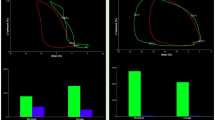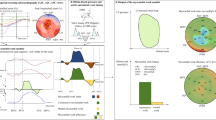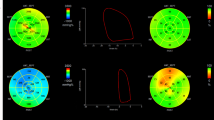Abstract
Chronic elevation of left ventricular (LV) afterload contributes to adverse LV remodeling and myocardial impairment in bicuspid aortic valve (BAV) patients with severe aortic stenosis (AS). Incorporating LV afterload into global longitudinal strain (GLS) analysis, myocardial work facilitates early detection of LV dysfunction. The present study was to evaluate myocardial work in BAV patients with severe AS undergoing surgical aortic valve replacement (SAVR) and to evaluate its prognostic impact on early postoperative outcomes. Between January 2021 and March 2022, BAV patients with severe AS scheduled for SAVR were included and underwent comprehensive transthoracic echocardiography. Quantification of LV myocardial work was performed to obtain LV global work index (GWI), global constructive work (GCW), global wasted work (GWW), and global work efficiency (GWE). Clinical outcome was defined as a composite of major cardiovascular events including mortality, myocardial infarction, stroke, acute kidney injury, low cardiac output syndrome and vascular complications during hospitalization or within 30 days after operation. Among 103 BAV patients with severe AS undergoing SAVR (mean age of 65 ± 9 years, 57.3% male), 22 experienced postoperative major cardiovascular events. BAV patients with major cardiovascular events demonstrated lower LV GWI (P < 0.001) and GCW (P = 0.002) along with elder age (P = 0.030), decreased LVGLS (P = 0.026) and right ventricular longitudinal strain (P = 0.019), and higher prevalence of abnormal average E/e’ ratio (P = 0.029) than those without major events. Decreased LV GWI and GCW was independently associated with the occurrence of major cardiovascular events (P < 0.01 for adjusted OR). Multivariable logistic regression model including LV GWI demonstrated superior power than the model including LVGLS and yielded best discrimination for BAV patients with and without major cardiovascular events during early postoperative period. Echocardiography-based LV myocardial work overcomes the limitations of LVGLS and presents as a promising novel index for the early detection of functional myocardial damage and the optimization of intervention timing among BAV patients with severe AS.




Similar content being viewed by others
Data Availability
All data generated or analyzed during this study are included in this published article.
References
Verma S, Siu SC (2014) Aortic dilatation in patients with bicuspid aortic valve. N Engl J Med 370(20):1920–1929
Borger MA, Fedak PWM, Stephens EH et al (2018) The American Association for thoracic surgery consensus guidelines on bicuspid aortic valve-related aortopathy: full online-only version. J Thorac Cardiovasc Surg 156(2):e41–e74
Michelena HI, Della Corte A, Evangelista A et al (2021) International consensus statement on nomenclature and classification of the congenital bicuspid aortic valve and its aortopathy, for clinical, surgical, interventional and research purposes. Radiol Cardiothorac Imaging 3(4):e200496
Michelena HI, Khanna AD, Mahoney D et al (2011) Incidence of aortic complications in patients with bicuspid aortic valves. JAMA 306(10):1104–1112
Wang Y, Wu B, Li J et al (2020) Distribution patterns of valvular and vascular complications in bicuspid aortic valve. Int Heart J 61(2):273–280
Rahhab Z, El Faquir N, Tchetche D et al (2020) Expanding the indications for transcatheter aortic valve implantation. Nat Rev Cardiol 17(2):75–84
Vincent F, Ternacle J, Denimal T et al (2021) Transcatheter aortic valve replacement in bicuspid aortic valve stenosis. Circulation 143(10):1043–1061
Otto CM, Nishimura RA, Bonow RO et al (2021) 2020 ACC/AHA guideline for the management of patients with valvular heart disease: a report of the American College of Cardiology/American Heart Association Joint Committee on Clinical Practice Guidelines. Circulation 143(5):e72–e227
Vahanian A, Beyersdorf F, Praz F et al (2022) 2021 ESC/EACTS guidelines for the management of valvular heart disease. Eur Heart J 43(7):561–632
Disha K, Dubslaff G, Rouman M et al (2017) Evidence of subannular and left ventricular morphological differences in patients with bicuspid versus tricuspid aortic valve stenosis: magnetic resonance imaging-based analysis. Interact Cardiovasc Thorac Surg 24(3):369–376
Chen H, Liang H, Wang T et al (2021) Evaluation of left ventricular myocardial mechanics in patients with normally functioning bicuspid aortic valves: a systematic review and meta-analysis. Echocardiography 38(6):834–843
Butcher SC, Pio SM, Kong WKF et al (2022) Left ventricular remodelling in bicuspid aortic valve disease. Eur Heart J Cardiovasc Imaging 23(12):1669–1679
Wedin JO, Vedin O, Rodin S et al (2022) Patients with bicuspid aortic stenosis demonstrate adverse left ventricular remodeling and impaired cardiac function before surgery with increased risk of postoperative heart failure. Circulation 146(17):1310–1322
Kong WKF, Vollema EM, Prevedello F et al (2020) Prognostic implications of left ventricular global longitudinal strain in patients with bicuspid aortic valve disease and preserved left ventricular ejection fraction. Eur Heart J Cardiovasc Imaging 21(7):759–767
Russell K, Eriksen M, Aaberge L et al (2012) A novel clinical method for quantification of regional left ventricular pressure-strain loop area: a non-invasive index of myocardial work. Eur Heart J 33(6):724–733
Fortuni F, Butcher SC, van der Kley F et al (2021) Left ventricular myocardial work in patients with severe aortic stenosis. J Am Soc Echocardiogr 34(3):257–266
Jain R, Bajwa T, Roemer S et al (2021) Myocardial work assessment in severe aortic stenosis undergoing transcatheter aortic valve replacement. Eur Heart J Cardiovasc Imaging 22(6):715–721
Baumgartner H, Hung J, Bermejo J et al (2017) Recommendations on the echocardiographic assessment of aortic valve stenosis: a focused update from the European Association of Cardiovascular Imaging and the American Society of Echocardiography. J Am Soc Echocardiogr 30(4):372–392
Kappetein AP, Head SJ, Généreux P et al (2012) Updated standardized endpoint definitions for transcatheter aortic valve implantation: the Valve Academic Research Consortium-2 consensus document. J Am Coll Cardiol 60(15):1438–1454
Maganti MD, Rao V, Borger MA et al (2005) Predictors of low cardiac output syndrome after isolated aortic valve surgery. Circulation 112(9 suppl):I448–452
Sugimoto T, Dulgheru R, Bernard A et al (2017) Echocardiographic reference ranges for normal left ventricular 2D strain: results from the EACVI NORRE study. Eur Heart J Cardiovasc Imaging 18(8):833–840
Addetia K, Miyoshi T, Citro R et al (2021) Two-dimensional echocardiographic right ventricular size and systolic function measurements stratified by sex, age, and ethnicity: results of the World Alliance of Societies of Echocardiography study. J Am Soc Echocardiogr 34(11):1148–1157
Manganaro R, Marchetta S, Dulgheru R et al (2019) Echocardiographic reference ranges for normal non-invasive myocardial work indices: results from the EACVI NORRE study. Eur Heart J Cardiovasc Imaging 20(5):582–590
Stefek HA, Berhane H, Robinson JD et al (2019) Comprehensive MR analysis of cardiac function, aortic hemodynamics and left ventricular strain in pediatric cohort with isolated bicuspid aortic valve. Pediatr Cardiol 40(7):1450–1459
Pan Y, Lin J, Wang Y et al (2022) Association of aortic distensibility and left ventricular function in patients with stenotic bicuspid aortic valve and preserved ejection fraction: a CMR study. Int J Cardiovasc Imaging 38(9):2025–2033
Ueshima D, Nai Fovino L, Brener SJ et al (2020) Transcatheter aortic valve replacement for bicuspid aortic valve stenosis with first- and new-generation bioprostheses: a systematic review and meta-analysis. Int J Cardiol 298:76–82
Yeats BB, Yadav PK, Dasi LP et al (2022) Transcatheter aortic valve replacement for bicuspid aortic valve disease: does conventional surgery have a future? Ann Cardiothorac Surg 11(4):389–401
Moriyama N, Miyashita H, Lehtola H et al (2022) Device failure in bicuspid aortic stenosis following transcatheter aortic valve implantation. Am J Cardiol 176:96–104
Jain R, Khandheria BK, Tajik AJ (2021) Myocardial work in aortic stenosis: it does work! J Am Soc Echocardiogr 34(3):267–269
Taconne M, Le Rolle V, Panis V et al (2022) How myocardial work could be relevant in patients with an aortic valve stenosis? Eur Heart J Cardiovasc Imaging 24(1):119–129
Wang Y, Wu B, Li J et al (2016) Impact of aortic insufficiency on ascending aortic dilatation and adverse aortic events after isolated aortic valve replacement in patients with a bicuspid aortic valve. Ann Thorac Surg 101(5):1707–1714
Marzlin N, Hays AG, Peters M et al (2023) Myocardial work in Echocardiography. Circ Cardiovasc Imaging 16(2):e014419
Podlesnikar T, Delgado V, Bax JJ (2018) Cardiovascular magnetic resonance imaging to assess myocardial fibrosis in valvular heart disease. Int J Cardiovasc Imaging 34(1):97–112
Roemer S, Jaglan A, Santos D et al (2021) The utility of myocardial work in clinical practice. J Am Soc Echocardiogr 34(8):807–818
Acknowledgements
The study was funded by National Natural Science Foundation of China grant No. 82071991 (Dr. Y Wang).
Author information
Authors and Affiliations
Corresponding authors
Ethics declarations
Conflict of interest
The authors declare no competing interests.
Additional information
Publisher’s Note
Springer Nature remains neutral with regard to jurisdictional claims in published maps and institutional affiliations.
Rights and permissions
Springer Nature or its licensor (e.g. a society or other partner) holds exclusive rights to this article under a publishing agreement with the author(s) or other rightsholder(s); author self-archiving of the accepted manuscript version of this article is solely governed by the terms of such publishing agreement and applicable law.
About this article
Cite this article
Lu, F., Wu, B., Li, J. et al. Left ventricular myocardial work for the prediction of postoperative outcomes in patients with bicuspid aortic stenosis. Int J Cardiovasc Imaging 39, 2497–2506 (2023). https://doi.org/10.1007/s10554-023-02959-y
Received:
Accepted:
Published:
Issue Date:
DOI: https://doi.org/10.1007/s10554-023-02959-y




